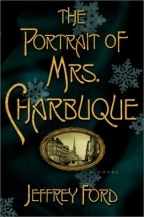The Portrait of Mrs. Charbuque
Jeffrey Ford
William Morrow / HarperCollins
US Hardcover
ISBN 0-06-621126-3
Publication Date: 06-04-2002
310 Pages; $24.95
Date Reviewed: 08-26-02
Reviewed by Rick Kleffel © 2002

REFERENCES
COLUMNS
|
|
|
The Portrait of Mrs. CharbuqueJeffrey FordWilliam Morrow / HarperCollinsUS HardcoverISBN 0-06-621126-3Publication Date: 06-04-2002310 Pages; $24.95Date Reviewed: 08-26-02Reviewed by Rick Kleffel © 2002 |
|
|
REFERENCES |
COLUMNS |
Some novels are too good to be trapped by genres. Jeffrey Ford's 'The Portrait of Mrs. Charbuque' is the fourth novel by this talented writer. While some might be tempted to call it 'magic realism', it's simply a great and imaginatively plotted novel set in New York city in 1893. It has elements of mystery, of nightmare and laugh-out-loud humor. Ford effortlessly re-creates the great metropolis from the stinking streets to the sickly-sweet salons. To take us on this tour of the city, Ford creates Piero Piambo, a talented portrait painter who still has aspirations to be a great artist. With no apparent effort, Ford creates a voice, a place and many stories to whisk the reader into a world as immediate as our own, yet as foreign as another planet. Part mystery, part meditation, 'The Portrait of Mrs. Charbuque' is unique yet accessible. Readers will find themselves compulsively turning the pages, yet treasuring the words. Jeffrey Ford's 'The Portrait of Mrs. Charbuque' is a standout mainstream work by a writer previously associated only with genre fiction.
As the novel starts, Piambo is offered a unique commission. He is asked to paint the portrait of a client who makes a unique offer. Mrs. Charbuque will pay him money beyond any sum he can imagine, let alone name. He may ask her any question about herself. But he may not, under any circumstance see her. She addresses him in a large room, from behind a screen. Piambo is allowed one hour per day to speak to her and sketch; the appointments are ended precisely upon the hour by her blind servant, Mr. Watkin.
Ford seizes upon this intriguing premise and takes it farther than any reader will be able to imagine that he can. But he doesn't focus solely upon Mrs. Charbuque. He brings an equally strong presence to all the other people with whom Piambo associates, from Shenz, his opium addicted fellow artist, to Sills, the policeman who draws miniature portraits of the criminals he catches, to Samantha, Piambo's girlfriend of many years. Each character is absolutely delightful to experience, and the reader looks forward to all of Piambo's encounters.
But of course, it is the mysterious Mrs. Charbuque who dominates proceedings. As Piambo obsesses, sketches, worries, dozes and doubts, she spins for him stories of her life that have the fragile universality of fairy tales, and within those stories, other stories are told. As Piambo's commission progresses, or not, a series of mysterious deaths within the city begin to alarm Sills and Piambo as well. Piambo begins to suspect that they are connected to Mrs. Charbuque, but the deaths appear to be the result of disease, not wrongdoing. The more Mrs. Charbuque tells Piambo, the more mysterious she becomes. The novel itself begins to become a literary mystery, as Ford steps effortlessly from humor to horror, from romance to revenge.
Ford's prose is fantastic. It's deployed in the interest of an intriguing plot, and serves up witty dialogue for a bevy of fascinating characters. He dots the narrative with enough historic details to himself paint a wonderful portrait of New York City over 100 years ago. He includes lots of interesting artistic subtleties, both in his writing and in his descriptions of the process of painting. "Much to my unease, Mrs. Reed positioned herself, all evening, beneath or immediately to either side of her new portrait. She had, for this occasion, worn the same black gown and diamond necklace I had requested she wear when posing for me. Given the situation, comparison between God's work and my own were unavoidable. I daresay the Almighty's original was found somewhat wanting in the face of my painterly revision. Whereas, in His unquestionable wisdom, He had gone for the grandiose in the formation of her nose and saw fit to leave a prominent gap between the front teeth, I had closed ranks and reduced to beautiful normalcy those aspects which made her so her."
'The Portrait of Mrs. Charbuque' is a definite crowd-pleaser with appeal to a wide range of tastes. From scatological humor to beautifully evoked snowscapes, Ford's novel covers a a variety of scenery and sensibility with graceful assurance. To be sure, Ford does keep his work edgy enough to please the discerning fan of the outré, but never so weird as to alienate legions of readers who line up to buy Alice Sebold's latest. Ford is probably not going to make the bestseller list this time around, but he deserves to. 'The Portrait of Mrs. Charbuque' is a novel to remember, to re-read, to enjoy as often as your favorite painting -- the one done by your own child.